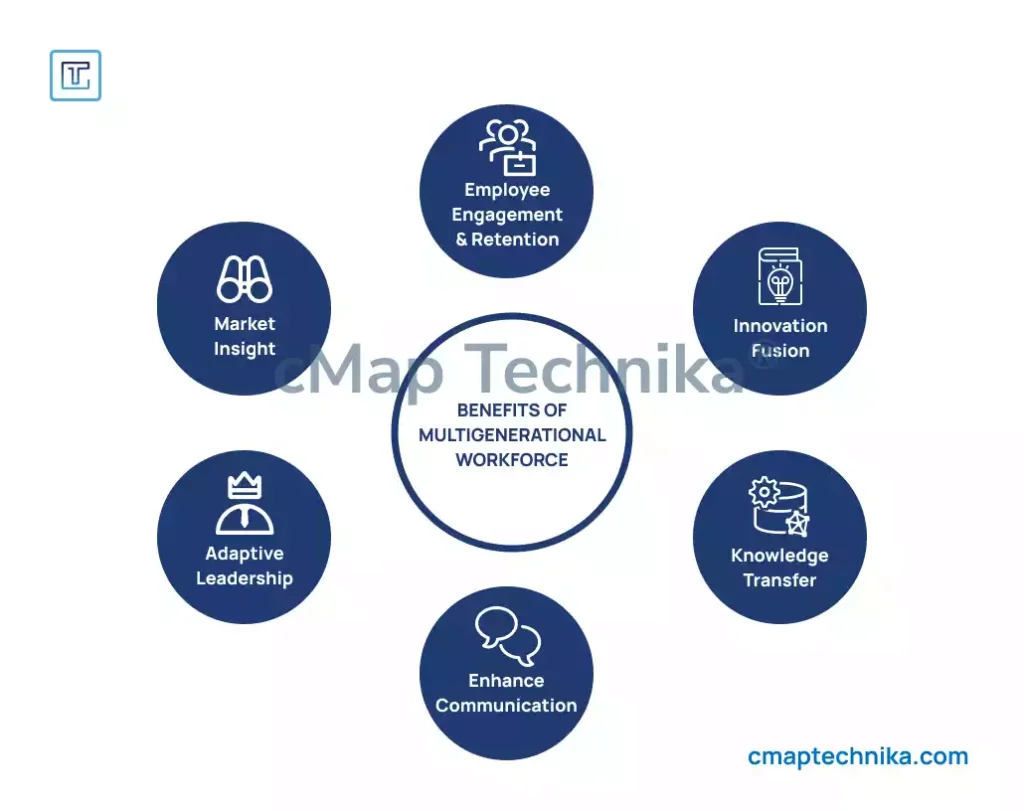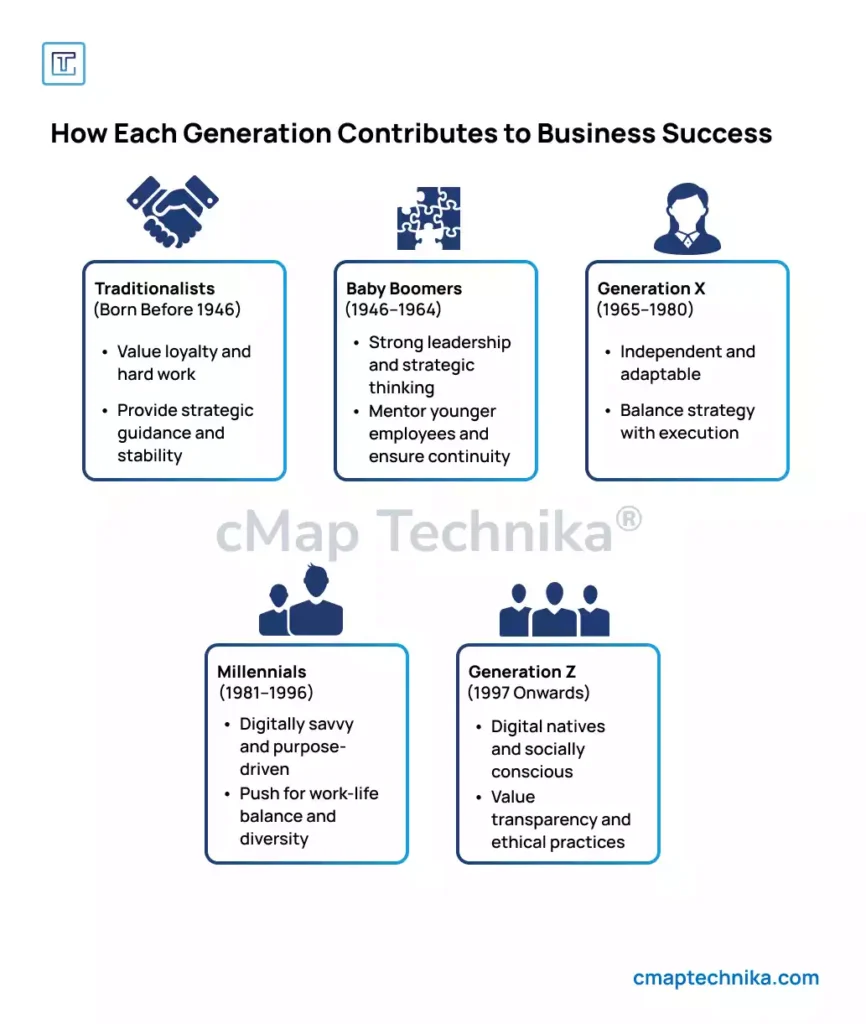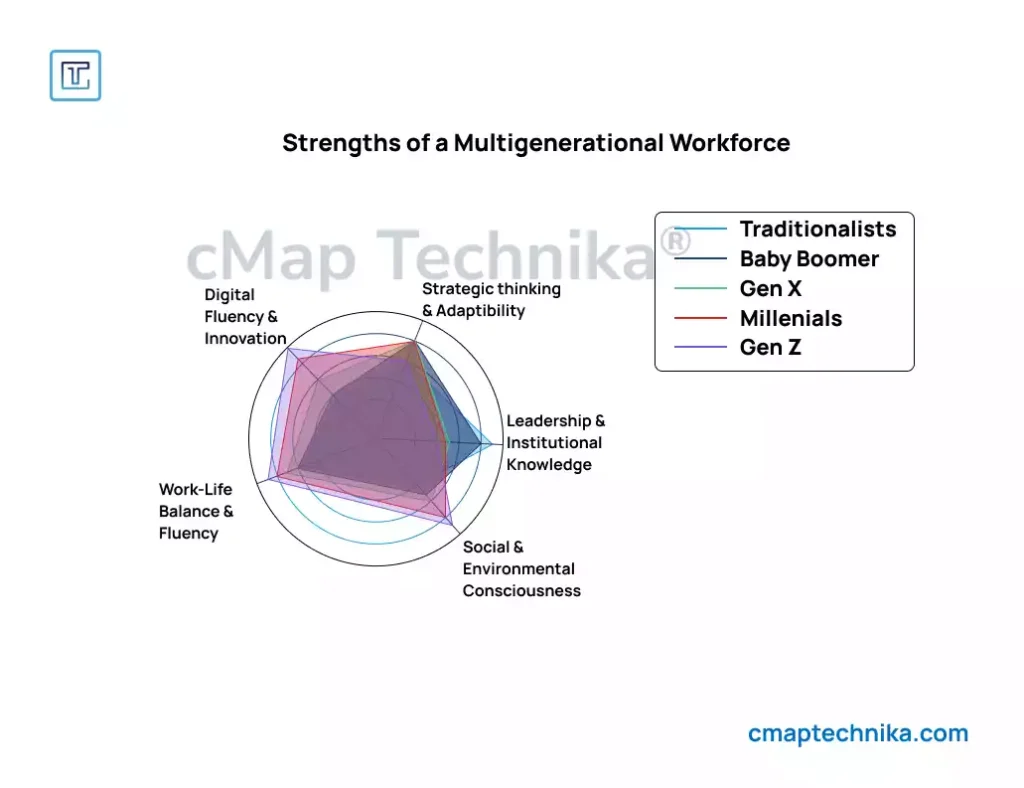Introduction: A Workforce Unlike Any Before
The modern workplace is a fascinating intersection of history and innovation. For the first time, businesses are witnessing five generations—Traditionalists, Baby Boomers, Generation X, Millennials, and Generation Z—working side by side. This unprecedented blend of experience, ambition, and technological fluency has the potential to drive unparalleled business success. Yet, many organizations struggle to harness this diversity effectively. The question is: how can businesses turn generational diversity into a strategic advantage?
The Business Case for Generational Diversity

Generational diversity is not just a matter of social equity; it is a tangible business asset. Research from McKinsey & Company shows that companies with diverse teams are 35% more likely to outperform their less diverse competitors. Different generations bring complementary strengths: Baby Boomers offer leadership and institutional knowledge, Gen Xers bridge strategic thinking with adaptability, Millennials introduce digital fluency and innovation, while Gen Z contributes fresh perspectives and social consciousness.
Consider IBM, a global leader in technology. The company has successfully leveraged generational diversity through its “Reverse Mentoring” program, where younger employees educate senior executives on emerging technologies and digital trends. This initiative not only bridges the generational gap but also ensures that IBM stays ahead in an ever-evolving tech landscape.
How Each Generation Contributes to Business Success

- Traditionalists (Born Before 1945)
Traditionalists, born before 1945, often hold semi-retired or advisory positions, offering businesses a deep reservoir of historical knowledge and corporate wisdom. Their emphasis on loyalty and perseverance fosters organizational stability, serving as a guiding force for long-term success. Having witnessed significant economic and technological shifts, they bring a unique perspective that balances tradition with progress. Their experience in navigating past crises can help companies build resilience and maintain ethical business practices. A striking example of this generation’s enduring impact is Warren Buffett, who, at 93, continues to lead Berkshire Hathaway with unparalleled financial acumen. His ability to adapt while staying true to core investment principles demonstrates that age is no barrier to visionary leadership, making Traditionalists an invaluable asset in shaping business strategy.
- Baby Boomers (1946–1964)
Baby Boomers, born between 1946 and 1964, have played a pivotal role in shaping modern corporate culture. Having spent decades in hierarchical business structures, they have developed strong leadership skills that emphasize discipline, strategic decision-making, and long-term vision. Their experience allows them to mentor younger employees, passing down institutional knowledge that ensures continuity and stability within organizations. This generational strength is particularly valuable during times of transition, where seasoned leadership can provide clarity and direction. A notable example is Howard Schultz, the former CEO of Starbucks, who returned to lead the company through a critical period of transformation. His ability to reinvigorate Starbucks’ brand and corporate strategy highlights the immense value of experienced leadership, demonstrating how Baby Boomers continue to drive business success even in evolving market landscapes.
- Generation X (1965–1980)
Generation X, born between 1965 and 1980, is often regarded as the “bridge” generation, seamlessly blending traditional corporate values with a strong ability to adapt to changing business landscapes. Having grown up during a period of rapid technological and economic shifts, Gen Xers are known for their independence, resilience, and pragmatic approach to leadership. They excel at balancing long-term strategy with hands-on execution, making them indispensable in managerial and executive roles. Their ability to navigate both legacy systems and emerging innovations positions them as key drivers of business transformation. A prime example is Satya Nadella, who, as a Gen X leader, revitalized Microsoft by shifting its focus from traditional software products to a forward-thinking, cloud-first strategy. His leadership exemplifies how Gen Xers leverage experience, adaptability, and vision to ensure businesses remain competitive and relevant in a rapidly evolving world.
- Millennials (1981–1996)
Millennials, born between 1981 and 1996, have fundamentally reshaped the modern workplace, driving a cultural and technological shift that prioritizes digital transformation, remote work, and purpose-driven business models. Having entered the workforce during the rise of the internet and social media, they bring a deep understanding of digital ecosystems, enabling businesses to innovate and stay agile in an increasingly connected world. Their emphasis on work-life balance, inclusivity, and mental well-being has pushed organizations to adopt policies that foster employee engagement, flexibility, and diversity, benefiting the workforce as a whole. Millennials also value authenticity and corporate social responsibility, challenging businesses to align profitability with positive social impact. A striking example of Millennial-driven innovation is Airbnb, co-founded by Brian Chesky and his peers, which revolutionized the hospitality industry by leveraging technology to create a global marketplace centered on experience-driven travel. Their ability to merge digital efficiency with user-centric experiences highlights the Millennial generation’s role in shaping businesses that are not only profitable but also forward-thinking and socially conscious.
- Generation Z (1997–2012)
Generation Z, born between 1997 and 2012, represents the first generation to grow up entirely in the digital age, making them exceptionally adept at navigating social media, leveraging data-driven decision-making, and adapting to rapidly changing technological landscapes. Unlike previous generations, they are highly attuned to corporate transparency, ethical business practices, and sustainability, demanding that brands align with their values rather than just offer products or services. Their influence has pushed companies to embrace social responsibility, environmental consciousness, and direct engagement through digital platforms. Gen Z values authenticity, preferring brands that demonstrate genuine commitment to causes rather than performative activism. A prime example of a company resonating with this generation is Patagonia, which has gained significant traction by embedding environmental sustainability into its business model, from using recycled materials to pledging its profits toward climate action. This alignment with Gen Z’s ethical expectations illustrates how businesses must evolve beyond profit-driven motives to build lasting relationships with the next wave of consumers and leaders.
The Challenges of a Multigenerational Workforce

While the benefits of generational diversity are clear, challenges remain. Communication gaps, differing work ethics, and technological disparities can lead to friction. For instance, Gen Z prefers quick, digital communication, while Baby Boomers may favor in-person meetings. Resolving these differences requires intentional strategies:
- Tailored Communication Styles: Companies like Deloitte implement multi-channel communication strategies to cater to different preferences.
- Cross-Generational Mentorship: At General Electric (GE), mentorship programs pair seasoned professionals with younger employees to encourage knowledge exchange.
- Flexible Work Policies: Companies like Google offer hybrid work models, accommodating varying generational expectations about work-life balance.
Turning Generational Diversity Into Competitive Advantage
In today’s rapidly evolving business environment, companies that successfully integrate generational diversity into their workforce gain a strategic edge. With employees spanning multiple generations—Baby Boomers, Gen X, Millennials, and Gen Z—organizations have access to a broad range of perspectives, skills, and experiences. However, simply having a diverse workforce isn’t enough. To truly capitalize on this advantage, businesses must create structures that encourage knowledge exchange, adapt leadership strategies to different generational needs, and foster a culture of inclusivity.
Encouraging Knowledge Sharing
A multi-generational workforce presents a unique opportunity for cross-generational learning, where seasoned employees can impart industry wisdom while younger professionals introduce fresh perspectives and technological expertise. However, to make this exchange effective, businesses must actively facilitate it.
One of the most impactful approaches is reverse mentoring, where younger employees mentor senior leaders, particularly in areas such as technology, digital trends, and evolving consumer behavior. This not only accelerates the digital transformation of businesses but also fosters a culture where learning flows in multiple directions.
???? Case Study: PwC’s “Shadow Board”—A Bold Approach to Reverse Mentoring
PwC, one of the world’s leading professional services firms, recognized the need to integrate younger employees’ insights into high-level decision-making. To address this, they introduced the Shadow Board concept, where a group of younger employees is given direct involvement in board-level discussions. This initiative ensures that executive leadership benefits from fresh, forward-thinking perspectives, particularly in areas of digital strategy, market trends, and workplace innovation.
PwC Italy, for example, successfully leveraged this approach to reshape its digital transformation strategy. By including younger employees in these discussions, the company was able to identify gaps in its existing digital services and pivot toward more customer-centric, technology-driven solutions. The Shadow Board not only drove more agile decision-making but also increased engagement and retention among younger employees, who felt more valued and heard.
Beyond formal programs, businesses can implement collaborative digital platforms where employees across generations can contribute ideas, share insights, and co-develop innovative solutions. Companies that actively encourage knowledge-sharing across age groups create a more adaptive and resilient workforce, prepared to tackle future challenges with a blend of experience and innovation.
Adapting Leadership Styles
Effective leadership in a generationally diverse workplace requires agility. Each generation has distinct expectations regarding management, communication, and career growth. Baby Boomers, for example, often value structured leadership, hierarchy, and in-person interactions, while Millennials and Gen Z employees prefer flexibility, continuous feedback, and digital-first communication. The challenge for today’s leaders is to balance these diverse needs while fostering engagement and productivity.
???? Case Study: PepsiCo’s Tailored Leadership Development Programs
PepsiCo, a global leader in the food and beverage industry, has recognized that leadership development cannot be a one-size-fits-all approach. To cater to its multi-generational workforce, the company has designed leadership programs that align with the unique aspirations of each generation.
For Baby Boomers, PepsiCo offers career extension and mentorship programs, enabling senior employees to transition into advisory roles while still contributing their expertise. Meanwhile, Millennials and Gen Z employees—who prioritize career mobility and hands-on learning—benefit from rotational programs, leadership acceleration tracks, and innovation-driven roles.
One of PepsiCo’s key initiatives is a leadership framework that promotes adaptability, where managers are trained to modify their leadership styles based on generational preferences. For example:
- Senior employees who prefer direct, face-to-face communication are provided with structured mentorship programs.
- Younger employees, who thrive on instant feedback and collaborative decision-making, are engaged through regular check-ins and agile work structures.
By acknowledging generational differences in leadership preferences, PepsiCo has been able to increase employee engagement, reduce turnover, and create a more dynamic and inclusive workplace. Companies that adopt similar adaptive leadership models ensure that employees across all age groups feel valued and motivated, ultimately driving business success.
Fostering an Inclusive Culture
To truly harness the benefits of generational diversity, organizations must go beyond surface-level diversity initiatives and actively build an inclusive culture where employees from all age groups feel a sense of belonging. One of the most effective ways to achieve this is through Employee Resource Groups (ERGs), which provide support networks for different generational cohorts and encourage cross-generational collaboration.
???? Case Study: Microsoft’s Intergenerational ERG—Building Bridges Across Age Groups
Microsoft has long been a pioneer in fostering an inclusive workplace culture. One of its standout initiatives is the Intergenerational Employee Resource Group (ERG), designed to connect employees across different age groups through mentorship programs, shared learning experiences, and cultural exchange initiatives.
Unlike traditional ERGs, which often focus on specific demographics (such as gender or ethnicity), Microsoft’s intergenerational ERG is designed to break down age-related barriers. Key components of the program include:
- Mentorship pairings between younger employees and seasoned professionals, facilitating knowledge transfer in both directions.
- Cross-generational project teams, where employees from different age groups collaborate on business challenges, leading to more well-rounded decision-making.
- Educational workshops that highlight generational strengths, helping employees understand how to work more effectively with colleagues from different age groups.
This initiative has led to improved knowledge retention, stronger workplace relationships, and greater innovation within Microsoft. Employees feel more valued, knowing their perspectives—regardless of their generation—are integral to the company’s success.
Beyond ERGs, businesses can foster an inclusive culture by implementing age-inclusive policies, flexible work arrangements, and cross-generational collaboration opportunities. Companies that actively integrate generational diversity into their cultural fabric create a work environment where every employee, regardless of age, can thrive.
Conclusion: The Future of Work is Multigenerational
Organizations that embrace generational diversity as a strategic asset rather than a challenge will be the ones to thrive in the coming decades. The key is to foster an environment where different generations complement rather than compete with each other. As the workforce continues to evolve, businesses must invest in intergenerational collaboration, adaptable leadership, and inclusive policies to maximize their Age Advantage.
For businesses looking to stay ahead, the message is clear: diversity isn’t just about gender or ethnicity—it’s about age too. The future belongs to those who understand that generational differences are not divisions but opportunities for innovation and sustained growth.






